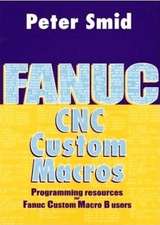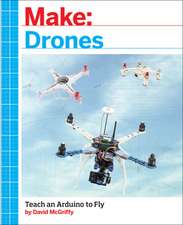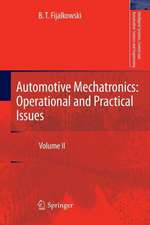Design, Modeling and Characterization of Bio-Nanorobotic Systems
Autor Mustapha Hamdi, Antoine Ferreiraen Limba Engleză Paperback – 15 oct 2014
| Toate formatele și edițiile | Preț | Express |
|---|---|---|
| Paperback (1) | 551.57 lei 38-44 zile | |
| SPRINGER NETHERLANDS – 15 oct 2014 | 551.57 lei 38-44 zile | |
| Hardback (1) | 641.20 lei 43-57 zile | |
| SPRINGER NETHERLANDS – 14 oct 2010 | 641.20 lei 43-57 zile |
Preț: 551.57 lei
Preț vechi: 689.46 lei
-20% Nou
Puncte Express: 827
Preț estimativ în valută:
105.58€ • 114.72$ • 88.74£
105.58€ • 114.72$ • 88.74£
Carte tipărită la comandă
Livrare economică 16-22 aprilie
Preluare comenzi: 021 569.72.76
Specificații
ISBN-13: 9789400797574
ISBN-10: 9400797575
Pagini: 188
Ilustrații: XXVII, 158 p.
Dimensiuni: 155 x 235 x 10 mm
Greutate: 0.27 kg
Ediția:2011
Editura: SPRINGER NETHERLANDS
Colecția Springer
Locul publicării:Dordrecht, Netherlands
ISBN-10: 9400797575
Pagini: 188
Ilustrații: XXVII, 158 p.
Dimensiuni: 155 x 235 x 10 mm
Greutate: 0.27 kg
Ediția:2011
Editura: SPRINGER NETHERLANDS
Colecția Springer
Locul publicării:Dordrecht, Netherlands
Public țintă
ResearchCuprins
1. Introduction. 2. Current State-Of-The-Art On Nanorobotic Components And Design. 2.1. Introduction. 2.2. Nanorobotics device structures. 2.3. Virtual Reality Techniques for Bio-nanotechnology Design. 2.4. Modeling and Characterization Methods. 2.5. Conclusion. 3. Methodology Of Design And Characterization Of Bionano- And Nanorobotic Devices. 3.1. Introduction. 3.2. Design and characterization methodology of biological nanodevices. 3.3. Co-prototyping of nanorobotic structures. 3.4. Conclusion. 4. Design And Computational Analysis Of Bio-Nanorobotic Structures. 4.1. Introduction. 4.2. Characterization of protein-based nanosprings. 4.3. Multiscale Design and Modeling of Protein-based Nanomechanisms. 4.4. DNA nanorobotics. 4.5. Design and Computational Analysis of a Linear Nanotube Servomotorusing DNA Actuation. 4.6. Multiscale platform as application for drug delivery characterization. 4.7. Conclusion. 5. Characterization And Prototyping Of Nanostructures. 5.1. Introduction. 5.2. Characterization of NEMS based on linear bearings. 5.3. Design of rotatory nanomotors based on head to head nanotubesn shuttles. 5.4. Attogram mass transport and vaporization through carbon nanotube. 5.5. Conclusion. 6. Conclusion and future prospects.
Textul de pe ultima copertă
Nanorobots represent a nanoscale device where proteins such as DNA, carbon nanotubes could act as motors, mechanical joints, transmission elements, or sensors. When these different components were assembled together they can form nanorobots with multi-degree-of-freedom, able to apply forces and manipulate objects in the nanoscale world. Design, Modeling and Characterization of Bio-Nanorobotic Systems investigates the design, assembly, simulation, and prototyping of biological and artificial molecular structures with the goal of implementing their internal nanoscale movements within nanorobotic systems in an optimized manner.
Design, Modeling and Characterization of Bio-Nanorobotic Systems focuses, mainly on two approaches. The first one involves multiscale modeling tools (quantum mechanics, molecular dynamics, continuum mechanics) coupled to virtual reality advanced techniques. In order to design and evaluate the characteristics of molecular robots, we proposed interactive nanophysics-based simulation which permits manipulation of molecules, proteins and engineered materials in molecular dynamics simulations with real-time force feedback and graphical display. The second approach uses a novel co-prototyping methodology, where the nanorobotic’s multiscale model is coupled to experimental measurements.
Design, Modeling and Characterization of Bio-Nanorobotic Systems presents a novel concept of nanorobots, bio-nanoactuators based DNA and rotating nanodevices based carbon nanotubes. In addition the presented platform helped to characterize the interaction between novel drug delivery systems and cellular membrane.
Design, Modeling and Characterization of Bio-Nanorobotic Systems focuses, mainly on two approaches. The first one involves multiscale modeling tools (quantum mechanics, molecular dynamics, continuum mechanics) coupled to virtual reality advanced techniques. In order to design and evaluate the characteristics of molecular robots, we proposed interactive nanophysics-based simulation which permits manipulation of molecules, proteins and engineered materials in molecular dynamics simulations with real-time force feedback and graphical display. The second approach uses a novel co-prototyping methodology, where the nanorobotic’s multiscale model is coupled to experimental measurements.
Design, Modeling and Characterization of Bio-Nanorobotic Systems presents a novel concept of nanorobots, bio-nanoactuators based DNA and rotating nanodevices based carbon nanotubes. In addition the presented platform helped to characterize the interaction between novel drug delivery systems and cellular membrane.
Caracteristici
Presents very rich and innovate research field. Presents recent state of the art on the field of bio-nanorobot Presents new methods of nanodevices Design map, modelling approaches and characterization methods Includes supplementary material: sn.pub/extras













